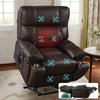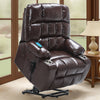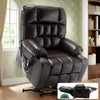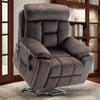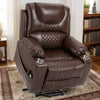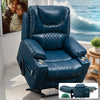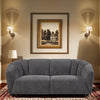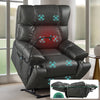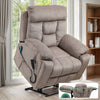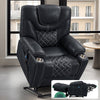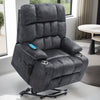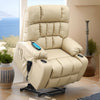Understanding the Therapeutic Value of Hot Oil Massage
The Science Behind Heat Therapy
Heat therapy has long been used to ease pain and promote healing. It works by increasing blood flow to the area. This boost in circulation brings more oxygen and nutrients to the tissues. For the elderly, heat can be especially soothing. It helps relax stiff muscles and joints. The warmth also triggers the release of endorphins, our body's natural pain relievers. This can lead to a sense of well-being and comfort. Heat therapy is often used to treat chronic conditions like arthritis. It's also helpful for muscle soreness and tension. When combined with massage, the benefits are even greater.

Oil Massage as a Complementary Health Practice
Oil massage is a practice that dates back thousands of years. It's a key part of many traditional healing systems. The use of oils enhances the massage experience in several ways. Oils reduce friction, allowing for smoother strokes. They also nourish the skin, which can be especially beneficial for older adults. Different oils offer various health benefits. For example, lavender oil can promote relaxation. Eucalyptus oil may help with respiratory issues. When heated, these oils can penetrate deeper into the skin. This allows for better absorption of their therapeutic properties.
Key Benefits of Hot Oil Massage for the Elderly
Hot oil massage offers numerous benefits for the elderly. Here are some key advantages:
- Pain relief: The heat and pressure can ease chronic pain.
- Improved circulation: Massage boosts blood flow throughout the body.
- Better sleep: The relaxing effects can lead to improved sleep quality.
- Reduced anxiety: Massage can help calm the mind and reduce stress.
- Increased flexibility: Regular massage can improve range of motion.
- Skin health: Oils can moisturize and nourish aging skin.
- Mental clarity: The calming effects can help improve focus and mood.
These benefits can greatly enhance the quality of life for older adults.
Best Practices for Providing Hot Oil Massage to Elderly Clients
Assessing Client Needs and Medical History
Before starting any massage therapy, it's crucial to assess the client's needs. This is especially important for elderly clients. A thorough review of their medical history is necessary. This should include any chronic conditions, medications, and recent surgeries. It's also important to discuss their goals for the massage. Some may seek pain relief, while others may want to improve mobility. Understanding their needs helps tailor the massage accordingly. It's also vital to get clearance from their doctor if there are any health concerns. This ensures the massage is safe and beneficial for the client.

Customizing Massage Techniques for the Elderly
Elderly clients often require gentler massage techniques. The pressure should be adjusted to their comfort level. Slow, steady strokes are usually more appropriate than deep tissue work. Areas of concern, such as arthritic joints, need special care. The choice of oil is also important. Some oils, like coconut oil, are easily absorbed by aging skin. Others, like jojoba oil, closely mimic the skin's natural oils. The temperature of the oil should be carefully monitored. It should be warm, but not hot enough to cause discomfort or burns. Massage duration may need to be shorter for elderly clients to prevent fatigue.
Ensuring Client Safety and Comfort
Safety is paramount when providing hot oil massage to elderly clients. The massage area should be easily accessible. Proper positioning is crucial to prevent strain or discomfort. Support pillows can help maintain comfortable positions. The room temperature should be warm to prevent chilling. Clients should be draped properly for modesty and warmth. It's important to communicate throughout the session. Check in regularly about pressure and comfort levels. Be alert for any signs of distress or pain. Have a call button or other means for the client to easily signal if they need assistance. After the massage, ensure the client can safely get up and move around.
Hot Oil Massage in the US Nursing Home Industry
Incorporating Massage Therapy into Elderly Care
Many US nursing homes are now incorporating massage therapy into their care plans. This shift recognizes the holistic benefits of touch therapy for the elderly. Some facilities have on-staff massage therapists. Others partner with local practitioners to provide regular sessions. Hot oil massage is often offered as part of a wellness program. It can complement other therapies like physical therapy or occupational therapy. Some homes even train their care staff in basic massage techniques. This allows for more frequent, informal touch therapy throughout the day. The integration of massage helps create a more nurturing environment for residents.

Success Stories: The Impact of Hot Oil Massage on Elderly Well-being
Numerous success stories highlight the positive impact of hot oil massage on elderly well-being. For example, a 78-year-old resident with chronic arthritis reported significant pain reduction. After regular sessions, she was able to participate more in daily activities. Another case involved an 85-year-old man struggling with insomnia. Hot oil massage helped improve his sleep quality, leading to better overall health. Many residents experience improved mood and decreased anxiety. Family members often note positive changes in their loved ones' demeanor. These stories underscore the potential of hot oil massage to enhance quality of life for the elderly.
Future Directions for Elderly Care and Massage Therapy Integration
The integration of massage therapy in elderly care is likely to grow. Research continues to support its benefits for older adults. Future directions may include more specialized training for geriatric massage. There's also potential for combining massage with other therapies. For instance, aromatherapy or music therapy could enhance the massage experience. Technology may play a role, with devices to assist in delivering consistent heat. As the population ages, demand for these services will likely increase. This could lead to more widespread adoption in nursing homes and assisted living facilities. The focus on holistic, non-pharmacological approaches to elderly care is set to continue.








